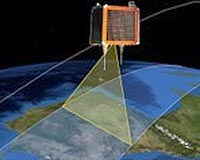 |
Bonn, Germany (SPX) Aug 13, 2009 Our solar system is in motion - the planets orbit the Sun and at the same time rotate around their own axes. This cosmic dance goes back to the origins of the solar system about 4.6 billion years ago. At that time, a huge cloud of gas and dust (consisting of the remains of earlier stars and of interstellar matter) began to coalesce under the influence to its own gravity. In doing so, the cloud began to rotate and formed itself into a disc. Our Sun developed at the centre of this rotating disc and, further out, numerous small objects, known as planetesimals, began to form. From them, the planets, moons, asteroids and comets formed. When the Sun, planetesimals and, later, planets developed, the angular momentum of the rotating disc was preserved - part of it in the rotation of the Sun and planetesimals around their own axes. The axes of rotation of the Sun and planetesimals - that is, the line around which the bodies rotate - were probably perpendicular to the plane of the original disc. The planetesimals of the inner solar system formed approximately a hundred protoplanets. They collided and created the planets as we know them today. These collisions probably tilted the axes of rotation of the planets away from being perpendicular to the plane of the original disc (and shifted the orbital planes of the planets around the Sun in relation to one another).
The axes of rotation of the planets - total disorder The axes of rotation of Venus and Uranus are particularly pronounced in their inclination. With Venus, the axis of rotation is tilted by 177 degrees, which means that the axis is almost perpendicular again - but upside down. Venus rotates in the opposite direction to the other planets and one Venusian day last slightly longer than one Venusian year. With Uranus, the tilt is 98 degrees - so the planet appears to 'roll' around the Sun and once a (Uranian) year the Sun is positioned above each of the planet's poles. Share This Article With Planet Earth
Related Links German Aerospace Center Station at NASA Station and More at Roscosmos S.P. Korolev RSC Energia Watch NASA TV via Space.TV Space Station News at Space-Travel.Com
 SSTL To Launch UK-DMC2 And Deimos-1 EO missions In July
SSTL To Launch UK-DMC2 And Deimos-1 EO missions In JulyLondon, UK (SPX) Jul 13, 2009 Surrey Satellite Technology Ltd (SSTL) is preparing two satellites for launch on 25th July. The Earth observation missions, UK-DMC2 and Deimos-1, will be launched onboard a Dnepr rocket from the Baikonur Cosmodrome on Saturday, 25th July 2009 at 18:46 UTC, 19:46 BST. The spacecraft, which are both based on the 100kg class SSTL-100 micro satellite platform, will join the international ... read more |
|
| The content herein, unless otherwise known to be public domain, are Copyright 1995-2009 - SpaceDaily. AFP and UPI Wire Stories are copyright Agence France-Presse and United Press International. ESA Portal Reports are copyright European Space Agency. All NASA sourced material is public domain. Additional copyrights may apply in whole or part to other bona fide parties. Advertising does not imply endorsement,agreement or approval of any opinions, statements or information provided by SpaceDaily on any Web page published or hosted by SpaceDaily. Privacy Statement |